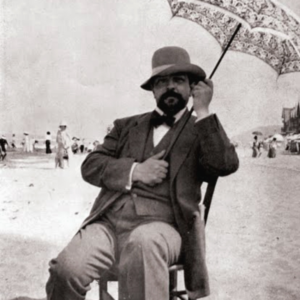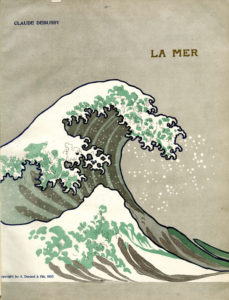On March 8, 9 and 10, the Houston Symphony presents a delectable all-French program featuring mezzo-soprano Susan Graham and Debussy’s La mer. In this post, discover how Debussy’s masterpiece revolutionized orchestral music. Get tickets and more information here.

Revolutionaries are often brash, noisy characters, iconoclasts intent on shattering traditions; Debussy, however, was a quiet revolutionary. Rather than shock his listeners, he sought to seduce them with beautiful sounds long outlawed by established laws of harmony and form. In place of rules of art passed down by his professors at the Paris Conservatoire, Debussy relied on intuition, living “in a world of imagination, which is set in motion by something suggested by my intimate surroundings […] I find an exquisite joy when I search deeply in the recesses of myself and if anything original is to come from me, it can only come that way.” More succinctly, he wrote, “There is no theory. You have merely to listen. Pleasure is the law…”
Predictably, he met with resistance from the French musical establishment. Members of the Académie des Beaux Arts famously condemned him, saying that “M. Debussy currently seems to be tormented by the desire to write music that is bizarre, incomprehensible and unperformable.” Their criticisms, however, are belied by the remarkable accessibility and sensual appeal of his music. After the undeniable success of works such as Prelude to the Afternoon of a Faun, Nocturnes and Pelléas et Mélisande, he at last won official recognition when he was made a Chevalier of the Légion d’Honneur in 1903.
Finding Inspiration

Soon after he began what is arguably his greatest masterpiece, La mer (The Sea), composed from 1903 to 1905. Though Debussy’s professional life was reaching new heights, his personal life proved tumultuous during this time as he left his first wife for a married woman. Many have speculated that this turmoil may have influenced the darker passages of La mer (particularly the stormy finale), but on the whole such personal influences seem to be subsumed in his ultimate source of inspiration: the sea.
While writing La mer, Debussy recalled his father’s early plans for his career in a letter to a friend: “You perhaps do not know that I was destined for the life of a sailor and that it was only by chance that I was led away from it. But I still have a great passion for the sea.” The ocean seems a perfect match for Debussy’s art, with its shifting shapes, sparkling surfaces and mysterious depths.
Debussy referred to La mer as “trois esquisses symphoniques” or “three symphonic sketches.” Though some have called La mer a symphony, it is perhaps more accurately an anti-symphony, as it deliberately eschews traditional symphonic form. Instead, it erodes these traditions by revealing alternatives, much as waves reshape even the rockiest coast. Debussy’s highly original conception from this extended orchestral work would suggest new possibilities to composers for generations to come.
The Anti-Symphony
Each movement of La mer bears a suggestive poetic title; the first is “De l’aube à midi sur la mer” or “From dawn to midday on the sea.” Frequently, composers imagine impossible effects and must use all of their ingenuity to create an illusion of what they hear in their heads; for instance, many composers have sought to create sounds that emerge from nowhere or fade away imperceptibly, even though every note written into a score must necessarily have a discrete beginning and end. Techniques of counterpoint and orchestration used to create these illusions are in many ways similar to a magician’s skillful misdirection or legerdemain.
With his desire to blur formal lines and create new sounds and textures, Debussy was especially interested in such ‘impossible’ effects, as the beginning of La mer shows. His use of the blended sonorities of timpani and double basses, the “echo” effect of the two harps playing a beat apart, and the overlapping lines of the cellos and violas come together to create a subdued, misty analogue of the darkness before dawn at sea:
Each element is distinct when played by itself, but together they rub against each other just enough to create a hazy, indefinable texture.
This slow introduction accelerates and crescendos to the main body of the movement, which arrives at a moment that suggests the sunrise. Instead of presenting an exposition with two contrasting themes, a development and a recapitulation as the first movement of a symphony would, Debussy reveals continuously developing episodes that wash over the orchestra like waves. Each contains a series of shifting moods, colors and textures; the flutes, double reeds (especially oboes and English horn) and cellos seem to have special roles in this movement. Several ideas use the pentatonic scale (a five note scale common in many cultures throughout the world) and some have a distinctive East Asian sound—a sign of the influence Asian music had on Debussy (especially the Javanese gamelan music he heard at the 1889 Universal Exposition in Paris). Though some motifs reappear from section to section, on the whole each part of the movement has its own melodic ideas. Despite this lack of recurring, recognizable melodies, the music is remarkably coherent. It unfolds naturally and intuitively in a way that resists theoretical explanation, building to a breathtaking coda in which one can hear waves crashing in the midday sun.
The second movement is titled “Jeux de vagues” or “Play of the waves.” This movement has a mischievous character similar to that of the traditional symphonic scherzo, but like the first movement, its form is sui generis. Though some melodic ideas presented at the beginning of the movement recur near the end, most of the movement is a continuous development of fragmentary motifs and melodic phrases, which playfully explore strange and enchanting new sounds.
The finale, “Dialogue du vent et de la mer” (“Dialogue of the wind and the sea”), is widely interpreted as a musical tempest. After a rumbling, fragmented opening, a melodic idea from the beginning of the first movement reappears in the trumpet—some have suggested that this is “the wind.” In this interpretation, “the sea” is represented by the following melody introduced in the oboes, English horn and bassoon above a churning accompaniment. The tumultuous music returns with the “wind” theme in the bassoons and pizzicato cellos, but dies away to a quieter passage. In this moment of calm, the horns introduce a chorale, interspersed with figuration from solo violins. The “sea” theme then returns, quietly at first, but building to a passionate incarnation for the full orchestra. The “wind” and “sea” themes alternate, until the chorale returns in a powerful guise, bringing La mer to a thrilling conclusion. —Calvin Dotsey
We want to hear from you! Tell us what you think in the comments below.
Don’t miss Debussy’s La mer March 8, 9 and 10, 2019! Get tickets and more information at houstonsymphony.org



